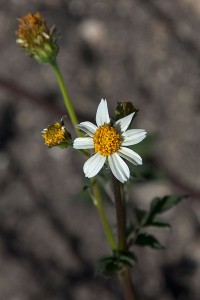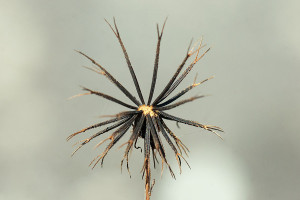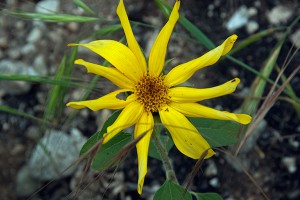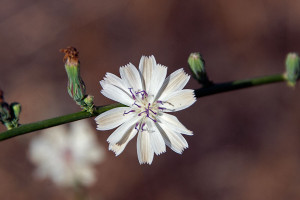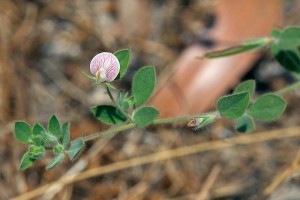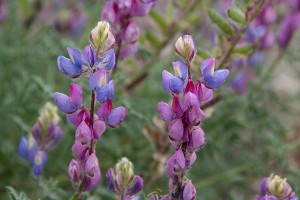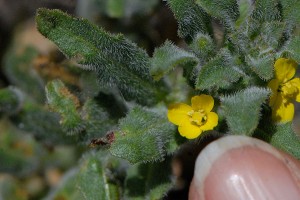Twelve new plants have been added to the BFS plant list. Eight of them were spotted in the area that burned in the Foothill Fire (September 11, 2013); six of these eight had not been seen at the BFS previously (the other two had been seen but not previously identified). The other four additions come from Justin Wood, who has been collecting BFS flora and depositing voucher specimens in the Rancho Santa Ana Botanic Garden herbarium.
In addition to Justin, we also thank all the other folks who’ve spotted, collected, identified, or vouchered the new additions, including Diane Thomson, Susan Schenk, Mare Nazaire, and Leroy Gross.
Here are the new additions;
- ASTERACEAE:
- Bidens pilosa (Common Beggar-Ticks)
Bidens pilosa is native to South and Central America, but has been introduced into many parts of the world, including Europe, Africa, Asia, and the Pacific Islands as well as North America. It grows well in many different habitats and soil types and is considered an invasive weed in most of its range. Common Beggar-Ticks is a troublesome weed for at least 30 crops in over 40 countries, significantly reducing crop yields, although it is not listed by the California Invasive Plant Council. At the BFS, a single plant appeared in the burn area in the East Field.
The common name “Beggar-Ticks” refers to the double-barbed seed, which easily sticks to the pants of beggars (and others). In fact the genus name Bidens comes from the Latin bis, meaning “twice”, and dens, meaning “tooth”, referring to the two barbs on each seed.
- Helianthus annuus (Common Sunflower)
A lone Common Sunflower was spotted by the side of the fire road in the East Field, just north of the Foothill Blvd fence. The Common Sunflower is, well, common — this annual is native to all of the lower 48 states and is the wild species from which the familiar garden and crop sunflower was derived. The heads follow the sun each day, facing eastward in the morning, westward at sunset.
- Helminthotheca echioides (Bristly Ox-Tongue)
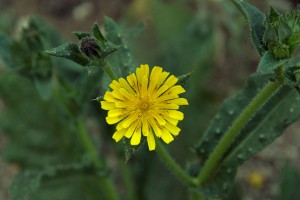
Flower of Helminthotheca echioides blooming in the burned area west of the entry drive. ©Nancy Hamlett.
Bristly Ox-Tongue, a Mediterranean basin native, is definitely “bristly”. Both leaves and stems have rigid hairs with hooked ends, and prickles arise out of “pimples” on the leaves. This annual weed is characteristic of disturbed places, and it was spotted in the burned area west of the entry drive. The California Invasive Plant Council considers Bristly Ox-Tongue to be invasive, but with limited ecological impact in California. Nonetheless, we pulled it out.
- Stephanomeria virgata ssp. virgata (Rod Wirelettuce, Twiggy Wreath-Plant)
This tall (up to 6′) annual blooms in late summer and early fall, with sparse white to dark pink flowers scattered along nearly leafless stems. Rod Wirelettuce is native to California, Nevada, and Oregon and is most frequently found in coastal Southern California. It grows mainly in open or disturbed areas, and at the BFS it is found mainly in the east field and south of the lake.
Another S. virgata subspecies, S. virgata ssp. pleurocarpa, had previously been identified at at the BFS, but this identification confirms our suspicion that the other subspecies was also present. The two subspecies are very similar, but S. virgata ssp. virgata has more ray flowers (“petals”) in the flowerhead, and outer phyllaries that are strongly reflexed.
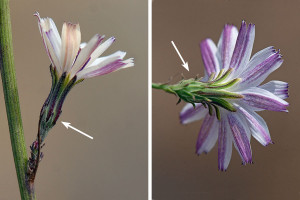
Left: Flowerhead of Stephanomeria virgata ssp. pleurocarpa showing fewer ray flowers (“petals”) and appressed outer phyllaries (arrow). Right: Flowerhead of Stephanomeria virgata ssp. virgata showing more ray flowers (“petals”) and strongly recurved outer phyllaries (arrow). ©Nancy Hamlett.
According to the Robert De Ruff’s Plants of Upper Newport Bay, “Delfina Cuero, a Kumeyaay or Southern Diegueno Indian, made the following comments about Stephanomeria virgata in her autobiography: ‘Gather the whole plant, it can be dried and saved. Boil the roots and drink liquid to get rid of intestinal worms. From Mexicans, we learned to boil whole plant to clean stomach after a hangover.'”
- Bidens pilosa (Common Beggar-Ticks)
- BRASSICACEAE:
- Lepidium lasiocarpum (Hairypod Pepperweed)
This small, weedy annual is uncommon at the BFS and was spotted in the open sandy areas in sage scrub west of the entry drive (prior to the burn). It has frequently been used in ecological studies of desert annuals, including bet-hedging, carbon and nitrogen dynamics during litter and root decomposition, and effects of grazing on annual diversity.
- Lepidium lasiocarpum (Hairypod Pepperweed)
- CARYOPHYLLACEAE:
- Silene antirrhina (Sleepy Catchfly)
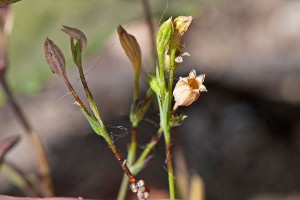
Flowers (closed) and fruits of Silene antirrhina. The red areas on the stems are the sticky patches. ©Nancy Hamlett.
Sleepy Catchfly is called “Sleepy” because its “sleepy” flowers are closed except in the morning, and it’s called “Catchfly” because the stems have sticky patches between the nodes that can fatally trap small flies and other insects. This little annual is native to most of North American and parts of South America. It can be found in a wide range of habitat types, including disturbed and recently burned areas, and it appeared in the burned area west of the entry drive.
- Silene antirrhina (Sleepy Catchfly)
- FABACEAE:
- Acmispon americanus (Spanish Clover)
Spanish Clover is not Spanish at all; it’s native to native to most habitats of California, the Western United States, Western Canada, and Northern Mexico. It’s not really clover, either, but at least it’s in the same family.
- Lupinus sparsiflorus (Coulter’s Lupine)
This pretty lupine had never been reported at BFS, but a plant appeared in the east field after the burn. Coulter’s Lupine is native to southwestern US from New Mexico to California and Nevada. Its flowers are typically blue, but may shade to pink, as was the case with the one spotted at the BFS.
- Acmispon americanus (Spanish Clover)
- ONAGRACEAE:
- Camissoniopsis micrantha (Minature Suncup)
We have realized for some time that we have several species of Camissoniopsis, but we were prodded to identify this one as we were censusing plants in the burn area. This charming annual is very hairy with tiny yellow flowers. It’s native primarily to southwestern and central Californi with some spread into Arizona and Baja California.
- Camissoniopsis micrantha (Minature Suncup)
- Clematis lasiantha (Chaparral Clematis, Pipestem Clematis)
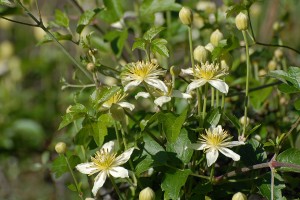
Clematis lasiantha blooming in the ‘Neck’ next to the Rancho Santa Ana Botanic Garden fence. ©Nancy Hamlett
We had previously thought that the Clematis lasiantha in the Neck next to the Rancho Santa Ana Botanic Garden fence was Clematis pauciflora, but it has now been determined to be Clematis lasiantha, which has a very similar appearance. We assume that this plant naturalized into the BFS from the Botanic Garden, although herbarium specimens were collected from Upland and Rancho Cucamonga early in the 20th century.
- Galium nuttallii subsp. nuttallii (San Diego Bedstraw)
San Diego Bedstraw is native to coastal Southern California, and is included in many plant lists from SoCal sage scrub communities. This small perennial is scarce at the BFS and was spotted in open areas of sage scrub west of the entry drive (prior to the burn).
- Ceanothus crassifolius (Hoaryleaf Ceanothus)
Although a California native, Hoaryleaf Ceanothus is not indigenous to the BFS, but was planted by John Gamon’s group at Cal State LA as part of an experiment on remote sensing of ecosytem productivity. Its natural distribution is on dry ridges or slopes below 3,700 feet through the Outer South Coast Range, Transverse Range, Peninsular Range, and northern Baja. It is a large evergreen shrub and has olive green leaves with white fuzzy (“hoary”) undersides and clusters of tiny white flowers. You can read more here.
